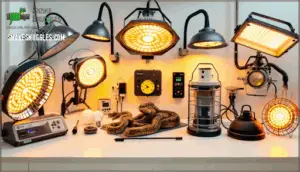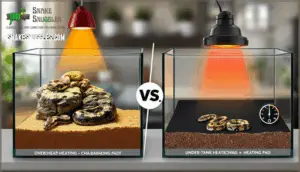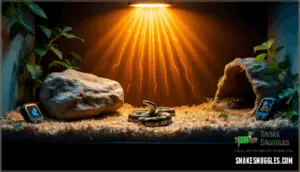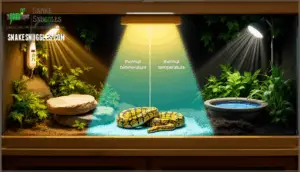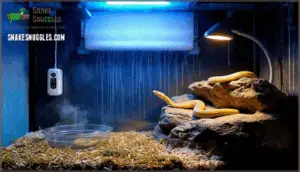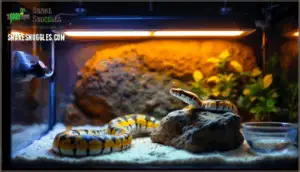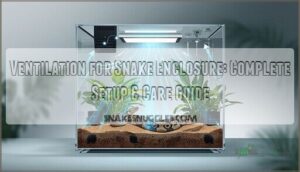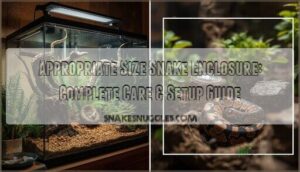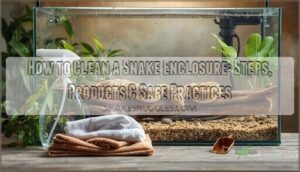This site is supported by our readers. We may earn a commission, at no cost to you, if you purchase through links.

Snakes evolved under predictable sunrise-sunset cycles, and breaking that rhythm throws their physiology into chaos. Getting your lighting right means understanding that snakes don’t need light to see prey—they need it to stay healthy. The difference between a thriving reptile and a chronically stressed one often comes down to whether you’re replicating what millions of years of evolution programmed them to expect.
Table Of Contents
Key Takeaways
- Light cycles control circadian rhythms that directly regulate appetite, immune function, and stress levels—proper photoperiods matter more than just heat for keeping snakes healthy.
- Most snakes need a 12-hour on/off lighting schedule with gradual dawn/dusk transitions, seasonal adjustments for temperate species, and complete darkness at night to maintain melatonin production.
- UVB lighting enhances vitamin D3 synthesis, calcium metabolism, and immune function, with T5 fixtures offering 40-60% better output than other options when mounted 10-14 inches overhead.
- Creating a thermal gradient (30-33°C basking zone to 21-24°C cool zone) with overhead heating mimics natural microhabitats and allows snakes to self-regulate their body temperature throughout the day.
Essential Lighting Needs for Snake Habitats
Getting your snake’s lighting right isn’t just about flipping a switch—it’s about recreating the rhythms they’d experience in the wild. Most snakes are crepuscular, which means they’re wired to be active during dawn and dusk, not blazing midday or pitch-black night.
Let’s walk through the three essentials that’ll help you nail their day-night cycle.
Importance of Day/Night Cycles
While most people think snakes just need heat, creating a natural day/night cycle is fundamental for your snake’s health. Consistent light exposure regulates circadian rhythms through the pineal gland, controlling melatonin production and daily activity patterns.
This hormonal regulation drives behavioral adaptations—when to hunt, bask, and rest. Without proper photoperiods, you’ll see disrupted feeding, stress responses, and weakened immunity.
That’s why captive management requires simulating natural nighttime darkness: it maintains the biological clock that keeps your snake thriving. In fact, light cycles influence snake activity.
Recommended Light Schedules
For most captive snakes, you should maintain a standard 12:12 lighting schedule—12 hours on, 12 hours off—to support their circadian rhythm. Crepuscular species like corn snakes benefit from this day-night cycle, while nocturnal species need complete darkness at nighttime.
Seasonal adjustments matter: increase to 13 hours in summer, drop to 11 in winter for temperate species. Automation technology like programmable timers helps maintain consistency, preventing melatonin suppression and supporting brumation effects when needed.
Paying attention to reptile’s photoperiod is vital for their overall health.
Simulating Natural Light Patterns
Going beyond a fixed 12-hour schedule, you’ll want to replicate how light actually behaves in nature—gradual sunrise, full-spectrum midday, and slow twilight. This promotes circadian rhythmicity and reduces stress. Here’s how:
- Dawn/Dusk Transitions: Use programmable dimmers to ramp light intensity gradually over 30-60 minutes
- UVB Integration: Sync full spectrum lighting with basking heat for photoperiod alignment
- Seasonal Simulation: Adjust day-night cycle length (11-13 hours) to trigger breeding or brumation
- ALAN Impacts: Eliminate artificial light at night to protect melatonin synthesis and circadian rhythm
Automated systems now handle these lighting schedule changes automatically.
Choosing The Right Lighting Equipment
Picking the right lighting gear makes all the difference between a thriving snake and a stressed one. You’ll need to decide whether UVB is worth adding, choose quality bulbs that actually work, and match them with safe fixtures.
Let’s break down your options so you can build a setup that keeps your snake healthy.
UVB Vs. Non-UVB Lighting Options
You’ll choose between UVB and non-UVB lighting based on your snake’s health needs. UVB lighting for snakes aids vitamin D3 synthesis, enhancing calcium metabolism and skeletal integrity.
Full spectrum lighting with proper spectral output also promotes behavioral enrichment, immune modulation, and improved coloration.
Non-UVB systems work, but snakes may show reduced bone density and require strict dietary supplementation over time.
Recommended Bulbs and Brands
Your best bet lies between Arcadia and ZooMed for reliable UVB lighting. Arcadia ProT5 UVB kits offer low-intensity 6% options with 20,000-hour lifespans, while ZooMed’s ReptiSun T5 HO fluorescent tubes deliver strong UVB output lasting about 12 months.
For heating, halogen innovations provide deep infrared warmth, and LED additions improve visibility without added heat—perfect alongside your primary UVB setup.
Proper Lighting Fixture Selection
You’ll find lighting fixture selection matters as much as the bulb itself. T5 HO linear fixtures with heat-resistant aluminum housings are your safest bet—they tolerate temperatures exceeding 250°C and boost UVB output by 40–60% through built-in reflectors. Mount them 10–14 inches overhead for consistent exposure.
Ceramic-socket dome fixtures work well for concentrated basking heat, while water-resistant IP44-rated options prevent electrical issues in humid setups.
Replace UVB bulbs annually since they lose 30–40% effectiveness after 12 months.
Setting Up Heating and Basking Areas
Getting the temperature right isn’t just about picking a heat source—it’s about creating zones your snake can move between. You’ll need to decide between overhead heating and under-tank options, then set up a proper gradient from warm to cool.
Let’s break down how to build a setup that keeps your snake comfortable and safe.
Overhead Vs. Under Tank Heating
You’ll need to choose between overhead heating and under tank heating based on your snake enclosure and species needs.
Overhead heating—like halogen bulbs or radiant heat panels—mimics natural sunlight by creating a proper thermal gradient throughout the habitat, which encourages basking behavior and maintains stable enclosure temperature.
Under tank heating works well for smaller setups where energy consumption matters, but it heats substrate more than air and doesn’t promote the same physiological outcomes or natural thermoregulation you’d see with overhead systems.
Safe Temperature Ranges for Snakes
Your snake’s survival depends on maintaining specific temperature ranges that aid its metabolism and immune function. Most species thrive at ambient air temperatures between 24–29°C (75–85°F), while basking areas should reach 30–33°C (86–91°F) to create a proper thermal gradient.
Monitor these core zones carefully:
- Basking temperature: 30–33°C creates the warm zone your snake needs for digestion and activity
- Cool zone: 21–24°C at night aids natural rest periods without triggering brumation risks
- Ambient air temperature: Keep it stable between 24–29°C to prevent overheating signs like excessive hiding
Species variations matter—ball pythons need 31°C basking spots, while garter snakes tolerate cooler ranges down to 20°C. Temperature monitoring prevents thermal burn risks and digestive stasis that occur below 21°C.
Creating a Thermal Gradient
Think of your enclosure as a road trip—your snake moves between warm and cool zones to regulate its core temperature. A proper temperature gradient lets it choose the ideal spot for digestion, rest, or activity throughout the day.
Position your heat source at one end, creating a basking area around 30°C while the cool zone stays near 24°C. This 5–6°C difference mimics natural sun-exposed and shaded microhabitats.
| Zone | Temperature Range |
|---|---|
| Basking area (warm end) | 30–33°C (86–91°F) |
| Ambient middle | 26–29°C (79–84°F) |
| Cool zone | 21–24°C (70–75°F) |
Use overhead heating like halogen bulbs for natural warmth distribution, supplemented by under-tank heating if needed. Install monitoring devices—dual-probe thermometers at both ends—to track gradient accuracy within 1°C.
Enclosure optimization matters: wooden vivariums retain heat 25–30% better than glass tanks. Adjust species parameters accordingly—corn snakes thrive with 24–29°C gradients, while tropical species need broader ranges.
Regulating Temperature and Humidity
Getting the temperature and humidity right isn’t something you set once and forget. You’ll need the right tools to track conditions inside your snake’s enclosure and make adjustments as needed.
Here’s what you should focus on to keep your snake comfortable and healthy.
Monitoring With Thermostats and Probes
Getting accurate temperature readings isn’t optional—it’s the foundation of proper snake care. You’ll need both a thermostat and digital probe thermometers to maintain species-specific ranges like 75–85°F on the cool side and 85–90°F on the warm side for corn snakes.
Here’s what matters most:
- Probe Placement: Position one infrared probe thermometer on your basking surface and another in the cool zone for balanced readings—never suspend probes in air, as this creates false ambient air temperature data
- Thermostat Types: Choose on/off models for heat mats, dimming types for light bulbs, or pulse proportional designs to minimize temperature fluctuations
- Calibration Frequency: Test accuracy using the ice-point method (32°F) when first installed, after impacts, or when readings seem off by more than 2°F
- Behavioral Cues: Watch how your snake moves—prolonged hiding from heated areas signals temperatures that are too high
- Seasonal Adjustments: Recalibrate settings when room temperatures shift between summer and winter to maintain stability
Maintaining Optimal Humidity Levels
Humidity levels directly affect respiratory health and shedding success. Ball pythons need 50–60% humidity, while corn snakes thrive at 65–75%.
Monitor at mid-height and substrate level using digital hygrometers—they’re accurate within ±3%. Substrate choice matters: coconut fiber and sphagnum moss retain moisture better than reptile carpet.
Seal screen lids partially to reduce evaporation by 30–40%, and add humid hides during shedding cycles for localized moisture near 80%.
Nighttime Temperature Drops
After maintaining humidity, consider temperature cycling too. Allowing nighttime drops from 70–75°F for corn snakes or staying above 72°F for ball pythons mimics natural conditions and promotes metabolic benefits. This thermoregulation behavior strengthens circadian rhythms without compromising health.
Use ceramic heat emitters with thermostats if your room drops below species thresholds—just dim the nighttime lighting and avoid constant night light exposure to preserve the day/night cycle.
Maintenance and Health Considerations
Setting up your snake’s habitat is just the beginning—keeping it safe and healthy requires ongoing attention. Even the best lighting setup can become a hazard without proper monitoring and maintenance.
Let’s look at the key practices that’ll protect your snake and keep its environment running smoothly.
Preventing Burns and Overheating
Burns are among the most preventable yet serious injuries in captive snakes, with thermal burn risks accounting for up to 15% of reptile veterinary cases. You can eliminate most dangers by following these core safety practices:
Burns account for 15% of reptile vet cases, yet most dangers vanish with proper thermostats, external heat placement, and vigilant monitoring
- Use thermostats on all heat sources – Thermostat calibration every six months prevents dangerous temperature spikes that cause burns
- Choose external placement for heat lamps – Positioning bulbs outside the enclosure reduces direct contact burns to nearly zero
- Install mesh guards on all accessible fixtures – These lower accidental contact incidents by 90% in curious snakes
- Monitor with a temperature gun – Check basking surfaces weekly to catch unsafe hotspots before injury occurs
Creating a thermal gradient with shaded zones gives your snake natural temperature control, preventing thermal burns by letting them self-regulate. Avoid heat rocks entirely—they’re responsible for over 50% of reported burn cases. Safe basking surfaces should never exceed 35°C when measured directly with your temperature gun.
Regular Bulb Replacement and Cleaning
Your bulbs won’t last forever, even when they look fine. UVB degradation happens invisibly—fluorescent tubes lose 30-50% of their output within six to twelve months of regular use. That’s why replacement intervals matter more than whether the light still turns on.
Here’s your maintenance schedule:
| Bulb Type | Replacement Interval | Cleaning Frequency |
|---|---|---|
| T5 UVB tubes | 12 months | Monthly wipe-down |
| T8 UVB tubes | 6 months | Monthly wipe-down |
| Halogen basking | 6 months | Bi-weekly dust removal |
| Ceramic heat emitters | 3-5 years | Quarterly inspection |
Performance monitoring with a solar meter every two weeks catches declining UVB before it affects your snake’s health. Dust blocks up to 20% of UVB transmission, so cleaning methods matter—use a microfiber cloth with diluted isopropyl alcohol on cool bulbs. Mark installation dates on your calendar. Poor enclosure maintenance raises vitamin D3 deficiency risks and increases electrical fire hazards by 15-25%. These lighting options need proactive care to maintain energy efficiency and safety.
Enhancing Snake Well-Being With Proper Lighting
When your lighting setup facilitates natural circadian rhythms and D3 synthesis, you’re investing in long-term snake health. Proper reptile lighting reduces stress indicators by up to 23%, while behavioral enrichment from day/night cycles boosts feeding response and activity.
Thermal regulation improves with basking zones between 32–38°C, and appropriate snake lights minimize health risks like metabolic bone disease.
Your snake habitat becomes more than shelter—it’s a system that promotes vitality through thoughtful lighting options.
Frequently Asked Questions (FAQs)
Can snakes see colored lights at night?
Yes, snakes can see colored lights at night, though their color perception focuses mainly on blue and green wavelengths.
Some species even detect UV light, which aids their low-light vision and nighttime activity.
Do LED lights work for snake enclosures?
LED lights work well as energy-efficient lighting options for snake enclosures—they’re like a steady sunrise without the heat. These snake lights excel at maintaining light cycles and offer excellent spectrum control. However, they emit minimal heat, so you’ll need separate heating for basking zones.
Many product adoption trends favor LEDs for ambient illumination.
How far should lights be from snakes?
Position your lights 10 to 12 inches above the basking area to prevent burns while assuring proper light intensity and heating.
Adjust the distance based on bulb wattage, enclosure material, and species needs—arboreal snakes often require higher placement than ground-dwelling species for suitable snake health and safety.
When should I turn off UVB lighting?
Turn off UVB lighting at night to maintain proper day/night cycles for your reptile. Using UVB timers ensures consistent circadian rhythms—usually twelve hours on, twelve hours off.
Complete nighttime darkness is best, though red lighting works for observation without disrupting your corn snake’s natural patterns.
Do albino snakes need different lighting?
Albino snakes need modified lighting due to pigmentation absence and increased UV sensitivity.
Use lower-intensity UVB (around 0) positioned farther from basking areas to prevent photophobia risks and tissue damage while supporting snake health and proper light management.
Conclusion
Your snake won’t tell you when the lighting’s wrong—it’ll just stop eating, shed poorly, or grow lethargic while you scramble for answers. Once you dial in snake habitat lighting requirements with consistent photoperiods, proper equipment, and vigilant temperature monitoring, you’re not just preventing problems—you’re unlocking the physiological rhythms that keep reptiles thriving.
Miss the mark, and even expensive enclosures become slow-motion stress chambers. Get it right, and your snake’s behavior becomes predictable, healthy, and proof that you’ve mastered what nature spent millennia perfecting.
- https://reptifiles.com/corn-snake-care-guide/corn-snake-temperatures-humidity/
- https://www.thebiodude.com/blogs/opinion-and-conservation-iniatives/red-bulbs-and-reptiles-why-they-are-detrimental-and-can-harm-your-pets-photoperiod
- https://reptilesandresearch.org/articles/do-snakes-need-uvb
- https://talis-us.com/blogs/news/best-lighting-options-for-snakes-improve-their-habitat-with-snake-lights
- https://nanoluxtech.com/can-you-use-led-grow-lights-for-reptiles/

